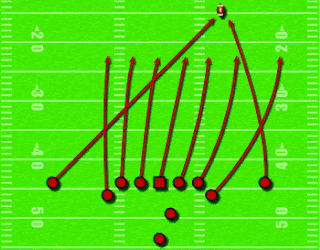 UCONN is trying to solve the trouble it had on special teams this past season. Specifically the punt unit. Coverage on punts was excellent (an outstanding job by Robby Frey and Terry Baltimore) however execution and protection left a little something to be desired.
UCONN is trying to solve the trouble it had on special teams this past season. Specifically the punt unit. Coverage on punts was excellent (an outstanding job by Robby Frey and Terry Baltimore) however execution and protection left a little something to be desired.Blocked punts were huge momentum swings in the UNC and Rutgers games (pivotal losses). Not to mention the poor field position or scores that resulted from all those blocked punts (something like 6 on the season).
UCONN plans to solve this in the coming season by installing a “spread punt” formation.
Cincinnati and Wake Forest are both examples of schools that use this system or punt-protection to execute this phase of special teams.
Spread vs.Tite
Formations
Instead of punt-protectors being shoulder to shoulder on the line of scrimmage and kicking back on the snap, instead they will be spread along the line of scrimmage.
This has two advantages, mainly it changes the blocking point for the opposition and makes punt coverage much easier for those racing downfield. If executed correctly it should help to alleviate the miscues UCONN had on this team in the 2008 season.
This has two advantages, mainly it changes the blocking point for the opposition and makes punt coverage much easier for those racing downfield. If executed correctly it should help to alleviate the miscues UCONN had on this team in the 2008 season.



Nothing like taking wider gaps to make it harder to rush the gaps. It’s this kind of thinking that has made our punt team what it is today.